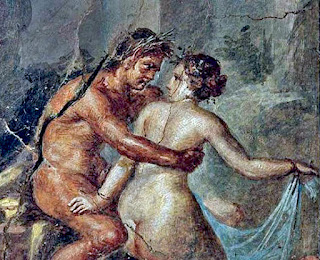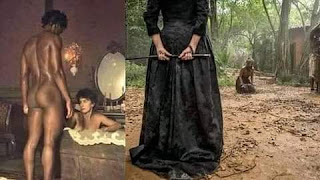SEX AMONG THE ETRUSCANS
SEX AMONG THE ETRUSCANS
The historian Theopompus, of the IV sec. a.c, at the court of Philip the Macedonian, is one of the sources of Etruscan usages, handed down from the quotations of Athenaeus, scholar and Greek grammarian in Rome in the II -III sec. d.
We must take into account that for the Greeks the freedom of women was an insult, and if it had equal dignity of man it was an abomination, so the news must be assumed with a lot of tare, a bit like when Christian historians wrote about pagans.
According to Theopompus among the Etruscans women were "held in common", but it is part of the denigration because the Etruscans had in high regard marriage and did not practice polygamy.
The Etruscan woman enjoyed much more freedom and rights than Greek and Roman women: she attended the banquets lying next to her husband, much to the scandal of the Greeks, who at the banquets did not admit women, if not ethers, luxury prostitutes.
Also according to Theopompus, Etruscan women took great care of their body, and so it was, of an elegant woman it was said in Rome that she "dressed in the Etruscan".
The Etruscans loved jewels, refined clothes, important hairstyles and showy makeup.But the historian also claims that they were naked even among men, who sat next to other men and who drank like males.
The Etruscans are always portrayed with sumptuous robes, except the dancers, who danced half-naked, with veils and scarves. For the choice of the partner in the banquet, this promiscuity does not result from the frescoes, apart from the wine that the Etruscans actually drank like men.
According to Theopompus, the Etruscans also produced children and raised them without knowing who the father was. But what was the reality?
The frescoes of the necropolis show men and women, depicted in sexual practices, but always adult and mature people.The children and boys, often naked, usual costume at that age, are represented in attitudes always appropriate to age, no one dared to touch them.
Theopompus then is scandalized by sexual exhibitionism in public, with a lot of group sex, exchange of couples and sodomy, but the Church also said this about the Romans, and unjustly.In Rome it was called "greek vice" the practice of seducing children of lower class to make it an object of pleasure.
Among the Etruscans there was sexual freedom, women and homosexuality, but there is no trace of the "greek vice" of molesting children.
Greeks and Romans disapproved of homosexuality that in Etruria naturally appeared in depictions, but did not disdain pederasty. Timaeus, Plato and Plautus, along with many others judge Etruscan women who lived free as unworthy while Greek sages locked them in the gynoecium treating them as slaves.
We know from historical and archaeological sources, that in Etruria sacred prostitution was practiced, hierodulia, as from every part of the world in the matriarchy.At the temple of Pyrgi the hierodules offered pleasure to pilgrims in exchange for money for the temple. Sex was not sin, and was even sacred.
Few depictions, as in the "Sarcophagus of the bride and groom", from the Banditaccia of Cerveteri, shows so much calm affection between two partners, lying in the same triclinium, where the husband affectionately holds a hand on the shoulder of his wife.The same tone and same pose the cinerary urn of the bride and groom in the Ceri Museum.





Comments
Post a Comment